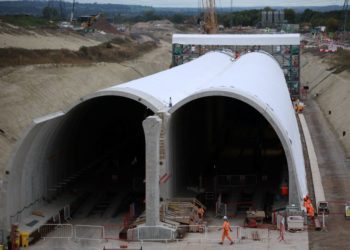(Bloomberg) — Donald Trump was elected on a pledge to fix all kinds of problems confronting the US economy, from stubborn inflation to a long-term decline in manufacturing jobs. He’s already declared that he’s off to the greatest start of a presidential term ever. The numbers don’t back him up.
Most Read from Bloomberg
The US economy shrank for the first time in three years in the first quarter — mostly a result of surging imports, as corporate America tried to front-run Trump’s tariffs. The rest of what economists call the “hard data” have been relatively solid since the president was inaugurated on Jan. 20, with the job market holding steady and inflation showing signs of stabilizing.
When it comes to the soft data, the picture is very different. Surveys of consumer confidence, corporate investment plans and expectations for growth and jobs have all plummeted — and the key reason is Trump’s trade war. His chaotic rollout of the highest US tariffs in more than a century has spread uncertainty throughout the economy. It’s showing up on financial markets too, with the worst stock-market performance — and the biggest dollar slide — at the same stage of any recent presidency. As for American voters, their faith in Trump as a steward of the economy was a key reason why he won last November — and that’s taken a hit too.
Following is a snapshot of some key economic numbers as they’ve evolved in the first 100 days of Trump II.
Trade
Trump has repeatedly professed his love of tariffs, and vowed to use them as a tool to reverse trade imbalances, raise revenue for the government, and revitalize manufacturing in America — including goods critical to national security. Still, the scale of the import taxes he’s imposed came as a shock to many. They add up to the highest protectionist barrier around the US in more than a century, even after Trump put some of the so-called reciprocal duties he announced April 2 on hold.
That U-turn, and several others — coupled with threats to impose still more tariffs — has left Americans and the country’s trading partners with little idea what to expect next. Global trade uncertainty, as measured by a Bloomberg Economics index, has spiked to levels that dwarf what happened during Trump’s first-term trade war.
Trump often points to the trade deficits that the US has been running for most of the past half-century as evidence that America is getting “ripped off” by its partners, and says tariffs will fix them. The immediate impact, though, has been the opposite. The US saw a surge in imports after Trump’s election, as companies rushed to buy foreign goods before tariffs ramped up the price. In dollar terms, the trade gap reached a record at the start of his second term, helping to push the economy into contraction.
Jobs
American businesses kept on hiring in Trump’s first months. The 456,000 jobs that have been added in the first three months of the year was more than forecast, and the unemployment rate has ticked up just slightly. “GREAT JOB NUMBERS, FAR BETTER THAN EXPECTED. IT’S ALREADY WORKING,” Trump said in an April 4 post on social media after the March data were released.
Anxiety about the future job market is on the rise, though. The share of Americans expecting unemployment to get worse in the next year is near the highest since 2009. Trump’s tariffs are widely expected to slow the economy down, at least for a while, and when that happens companies tend to retrench on payrolls.
Inflation and Spending
The surge in consumer prices under Biden was the steepest in about four decades, so Trump’s campaign promises to get them under control had resonance. Inflation cooled in the early months of his second administration, with the headline rate matching the lowest recorded since early 2021. That reflects a decline in energy costs, used vehicles, hotel stays and airfares.
Again, there’s a gap between hard data and soft numbers from the surveys about what comes next — and again, trade war is the reason. Most economists predict that Trump’s tariffs will make the prices of imported goods more expensive, with knock-on effects on domestic products too — causing inflation to accelerate. Consumers seem to agree, with surveys showing that expectations for both short- and long-term inflation have soared.
There was a frontloading effect on retail sales from the escalating trade war, as consumers scrambled to buy automobiles, computers and other big-ticket items in case tariffs made them more expensive. At the same time, fears of higher inflation and slower economic growth caused measures of consumer confidence to plummet.
Business Investment
By one measure, US output of business equipment the first quarter was the strongest since 1978, excluding pandemic swings — helped by a surge in aircraft-related production. That represents an encouraging signal for Trump’s push to revive domestic manufacturing.
But uncertainty around how and when Congress will enact tax legislation, on top of Trump’s vacillating tariff announcements, is causing many companies to put their investment plans — a key driver of economic growth — on hold.
Optimism among small businesses soared after Trump’s election victory on the belief he’d pursue tax cuts, deregulation and other business-friendly policies. Many such measures are in the pipeline, but it’s not clear when they’ll take effect. Meanwhile, since tariffs can be especially damaging to smaller firms, their expectations have soured amid the president’s initial focus on trade issues.
Immigration
A crackdown on illegal immigration — along with the biggest mass deportation in US history — was among Trump’s highest-profile campaign promises, and since he took office monthly border crossings have plummeted close to zero. There might be a downside for the economy, since the removal of what’s been a boost to the workforce threatens to choke off a key growth engine just as tariffs are poised to bite.
Markets
Trump often bragged about how well US stocks performed during his first term, at least before the pandemic, as a validation of his economic policies. Largely as a result of his whipsawing tariff announcements, his second administration has begun with the worst stock market performance of any recent presidency — one that threatens a knock-on effect on the economy, since rising equity wealth translates into more consumer spending.
Treasuries have long been a safe haven for investors in America and across the world. The Trump administration has said it will focus on trying to get interest rates on the bonds down, since they’re a benchmark for lots of other kinds of borrowing, including mortgages.
The rate on the 10-year Treasury note posted one of the sharpest spikes on record around the time of Trump’s major tariff announcement on April 2, climbing close to 4.6%. Some investors saw it as a sign of diminishing global confidence in American assets. But yields have retreated since then, to trade roughly where they were at the time of Trump’s election and well below the levels when he took office.
Trump’s position on the dollar has been ambivalent, sometimes signaling that he’d prefer a weaker greenback to help exporters, and at other times stressing the dollar’s strength and its role as the world’s preferred money. What’s happened so far in his presidency is a sharp decline.
Trump promised to achieve US “energy dominance,” and also that he’d deliver lower costs. Oil prices have indeed fallen since he took office. It’s largely due to concerns about an economic slowdown, though the oil giants in the OPEC+ group may also have heeded the president’s calls for more output, which helps bring prices down.
Trump Approval
Most US adults disapprove of Trump’s job performance and the major actions of his first 100 days: tariff increases, cuts to federal agencies, and ending diversity, equity and inclusion programs.
Consumer confidence in how the government is handling economic policy reached an all-time low. Gauges like that tend to show a sharp divergence according to political affiliation, but it’s striking that sentiment has worsened among independents and Republicans as well as Democrats.
Economist Surveys
Economists have dialed back their expectations for US growth this year, and increased their estimate of recession risks, amid mounting uncertainty around the trade war, according to the latest Bloomberg survey.
The April edition put the chances of a contraction in the next 12 months at 45%, up from 30% in the previous month.
–With assistance from Vince Golle and Cecile Daurat.
Most Read from Bloomberg Businessweek
©2025 Bloomberg L.P.
The post Trump Says He’s Off to Best Start as President. The Economy Says Something Else appeared first on Bloomberg.




